Defining ”The Greats”
Homo Sapiens (modern humankind) first walked the Earth about 50,000 years ago. The Population Reference Bureau (PRB) has estimated that around 108 billion people have been born in that time. Of those billions of people, there are only around forty individuals that have had the suffix ”the Great” added to their name. The tag ”the Great” recognises this highly unique group as some of the greatest leaders that have ever lived.
According to Malvolio in Shakespeare’s Twelfth Night, “Some are born great, some achieve greatness, and some have greatness thrust upon them”. So, just what does it take to realise that ultimate accolade of being dubbed “the Great”? If that’s a question you have ever pondered, here’s an overview of five “Greats” from antiquity.
Alexander the Great (circa 356 –323 BC)
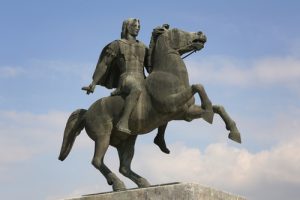
Alexander III of Macedon, who became much better known as Alexander the Great, was a king of the ancient Greek kingdom of Macedon. He was born in Pella in 356 BC, a member of the Argead dynasty. In 336 BC, at the age of 20, Alexander succeeded his father to the throne of Macedonia. He created the world’s largest contiguous empire that has ever existed in less than 4 years. Within 2 years he had conquered Persia, much of modern-day Iraq, Turkey, and Iran. Two years later he had taken control of Egypt, where he was hailed as the new Pharaoh.
A Short Life
His empire eventually stretched from Greece in the West, all the way to India in the East. However, Alexander’s life was to be cut tragically short. In 323 BC, while visiting the city of Babylon he contracted a mysterious fever. It was to end his life while he was still in his prime, aged only 33 years old. Since there was no natural successor to Alexander, the huge Macedonian Empire collapsed within a few years. However, the trade routes that were established between Europe and Asia during his rule survived for many centuries.
A renowned comment on Alexander
It was famously said of Alexander that; “He cried when he found there were no more lands to conquer”.
Almost certainly the best-known of all history’s ‘Greats’, does he qualify as ‘The Greatest of the Greats’? Read on!
King Alfred the Great (circa 847 – 899)
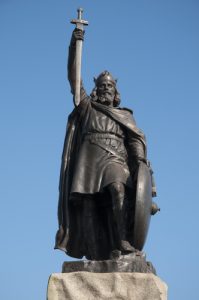
King Alfred of Wessex, better known as King Alfred the Great, is easily the best remembered of all the Anglo-Saxon rulers of England. History best remembers him for burning the cakes of a cow herder’s wife while taking shelter in their humble abode. He obviously wouldn’t have made the grade on TV’s ‘Bake Off’. However, putting his trivial but well-publicised faux-pa aside, his achievements are considerable.
Alfred was the youngest of six siblings, four of them brothers. His eldest brother, Æthelstan, died while he was still in infancy. Alfred’s next three brothers were crowned successive kings of Wessex. but all died in battle at the hands of the Viking invaders. Alfred came to the throne of Wessex in 871 when he was about 23 or 24. While, the main English kingdoms of Northumbria, East Anglia, and Mercia had all fallen to the Vikings, Wessex under Alfred’s reign, remained as the only surviving Anglo-Saxon province.
A decisive victory by Alfred at the battle of Edington in 879, saw the tide begin to turn on the Viking invasion. He reorganised the military and began building up a ring of garrisoned forts, known as burhs, to defend against any would-be attackers. He quickly became very much viewed as the defender of the Christian faith, rallying the indigenous population against the pagan Vikings. More burhs were built until much of the South of England was encompassed in a ring of fortified towns. It was Alfred who paved the way for the mid-10th century unification of England as one country. A feat that was ultimately brought about by Alfred’s son and grandsons.
A Fitting Epitaph
Alfred is thought to have written his own epitaph based on his understanding of the works of 6th-century Roman philosopher, Boethius. It reads: ‘‘I desired to live worthily as long as I lived, and to leave after my life, to the men who should come after me, the memory of me in good works.”
Cyrus the Great (circa 590 – 529 BC)
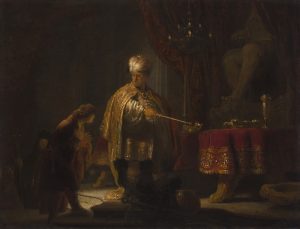
Like many ancient rulers, the Persian conqueror, Cyrus the Great (aka Cyrus II), was born into royalty. On the death of his father c. 559 BC, Cyrus found himself at the head of the Achaemenid dynasty when he was around 30 years old. A brilliant military strategist, Cyrus soon overcame the king of the Medes, integrating the Iranian tribes into his rapidly expanding army. He then triumphed in Lydia, Western Asia Minor, taking control of its natural resources and its trade routes which ran between the Mediterranean and Asia.
Cyrus eventually became ruler of the world’s largest empire. It stretched more than 3,000 miles, encompassing Mesopotamia (Western Asia) Egypt, Israel, and Turkey. Although a fervent expansionist, he was also known as a tolerant and benevolent leader. He viewed himself very much as a liberator rather than a conqueror. Cleverly, Cyrus allowed all his new subjects to continue their customs and religious practices in return for their loyalty.
It was Cyrus that allowed more than 40,000 Jews to return to Jerusalem after being held in captivity in Babylon for some 70 years. In 1879, British archaeologists unearthed The Cyrus Cylinder in modern-day Iraq. The clay casket contained documentation that chronicled Cyrus’s conquest of Babylon. Regarded as one of the most important discoveries of the ancient world, the cylinder is considered to be the world’s first bill of human rights. It bears witness to Cyrus’s exemplary style of rule.
Cyrus Immortalised
Some 150 years after Cyrus’s death, the Greek author Xenophon immortalised him in the part-fictionalised biography of his life, the Cyropaedia. Xenophon wrote of Cyrus, “He honoured his subjects and cared for them as if they were his own children”. A replica of the Cyrus Cylinder is on permanent display at the UN headquarters in New York.
Charles the Great (Charlemagne) (circa 747 – 814)
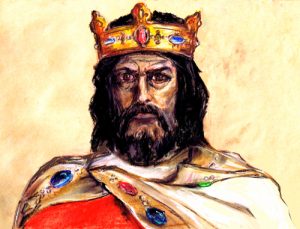
Charlemagne, which translates as “Charles the Great” in Old French, is considered one of the greatest leaders of the Middle Ages. He did much to define the shape and character of medieval Europe in the period that would become known as the Carolingian Renaissance. A determined and competent leader, he was responsible for carrying out a great deal of reform. This includes many everyday aspects of life, with regards to government, law, the arts, education, cultivation, and the church.
Charlemagne was born around 747 in Liège (modern-day Belgium), the son of the Frankish king Pepin the Short. When Pepin died in 768, his kingdom was split between his two sons, Charlemagne and his younger brother Carloman. However, only 3 years later, Carloman died suddenly, leaving Charlemagne as sole ruler. Charlemagne decided a policy of expansionism was the way forward. In 772, he invaded Saxony, eventually converting his new subjects to Christianity. He then extended his kingdom southwards by capturing northern Italy. By 778, he had also successfully invaded northern Spain, displacing the Moors.
A Bloody Christian
Despite being a committed Christian, Charlemagne’s reign was not without bloodshed. One notable such occasion occurred in 782 when he led the Franks at the Massacre of Verden. It was there that he reportedly ordered the slaying of some 4,500 Saxons who had refused to convert to Christianity. In 800, Charlemagne went to the aid of Pope Leo III who had been attacked by a group of thugs in Rome. When those responsible were brought to justice, Leo’s gratitude was such that on the Christmas day of 800, he declared Charlemagne, “Emperor of the Romans”.
After a reign of more than 45 years, Charlemagne died in 814, leaving behind numerous wives, mistresses, and children. He was buried in a gold casket at Aachen Cathedral in western Germany. However, his successors lacked his vision and leadership skills, which resulted in the rapid collapse of the Frankish empire. In 1165, he was canonised by Emperor Frederick Barbarossa for his many great acts. However, his status was never officially recognised by the church.
A Wise Quote
One of the many wise quotations attributed to Charlemange, states; “Right action is better than knowledge; but in order to do what is right, we must know what is right.”
Constantine the Great (circa AD 272 – 337)
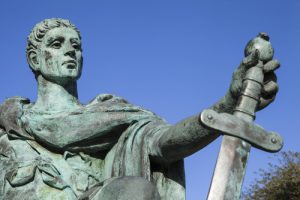
Constantine the Great reigned over arguably the biggest transition period of the Roman Empire. History has labelled him as the first Christian Roman emperor, although he only formally converted to the faith on his deathbed. He was responsible for establishing the imperial city of Constantine in the Eastern empire. The kingdom went on to far outlive that of the west, seeing its capital eponymously named in his honour.
Constantine the Great, also known as Constantine I, was a Roman emperor between AD 306 to 337. He was born in Dacia Ripensis (modern-day Serbia), the son of Flavius Constantius, an army officer who became one of the four emperors of Rome’s Tetrarchy. In 305, after being instrumental in successful military campaigns in the eastern empire, he was transferred to Britain to fight under his father.
After his father’s death in AD 306, Constantine was acclaimed as emperor by his soldiers at Eboracum (York). He spent the next 18 years striving to reunite the Roman Empire under one ruler. In 312, he defeated his brother-in-law, Maxentius at the Battle of Milvian Bridge. He then became Rome’s Western emperor, a feat he credited to god. In 324, he became the first sole ruler of the Roman empire for some 40 years.
Leaving Rome
After achieving his ultimate goal of leadership, Constantine became increasingly disillusioned with life in Rome. His strengthening Christian beliefs put him at loggerheads with the mostly pagan Rome. Constantine had the revelation that the valuable eastern territories would be far better protected by establishing an impressive stronghold in the region. In AD 330, he left Rome for good to build a city that was a worthy imperial seat of power.
Although Byzantium (modern-day Istanbul) had been under Roman control for well over a century, Constantine rebuilt and expanded the city on a monumental scale. Renamed Constantinople, the existing city expanded by as much as 300% within decades. A grand palace and imposing legislative halls were constructed, befitting the new capital. Immigrants, particularly Christians were welcomed, with those of other faiths being tolerated.
In due course, Constantinople went on to eclipse Rome in importance. The western empire eventually collapsed, culminating in the fall of Rome in 476. Contrarily, Constantinople went to thrive as the Byzantine capital for a thousand years, until it fell to the Ottomans in the 15th century.
A Famed Quote
One of Constantine’s best-known quotes, states; “How pleasing to the wise and intelligent portion of mankind is the concord which exists among you!”





